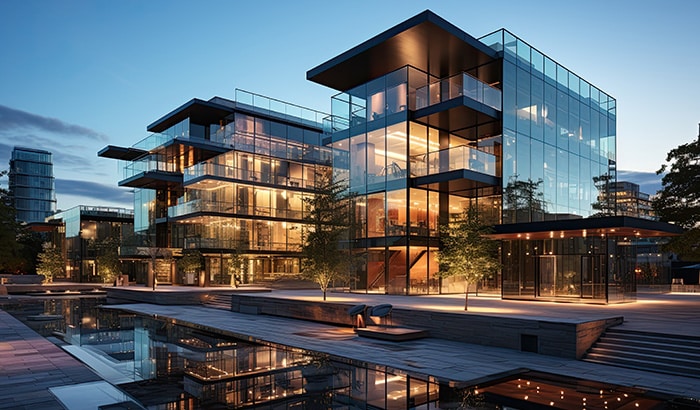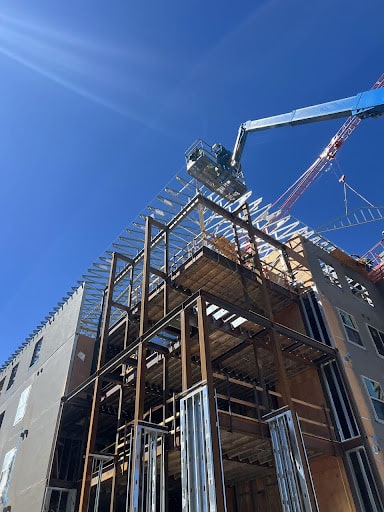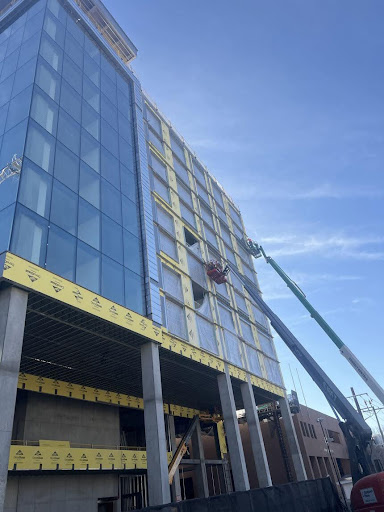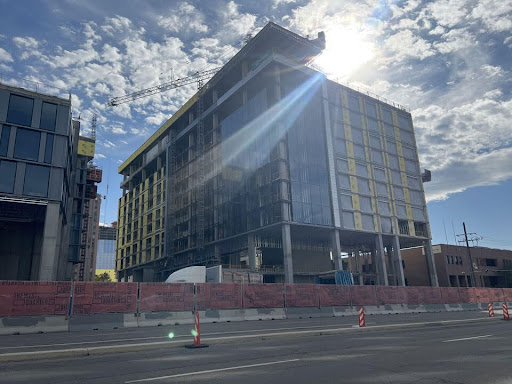Floor trusses are a fascinating and increasingly popular element in the construction of multi-story buildings. Thanks to expert engineering, these frameworks support the weight of multiple floors by evenly distributing the load across the building. The role of floor trusses is becoming more pivotal than ever, sparking interest among architects, builders, and developers alike.
The surge in the use of floor trusses in recent years is a response to the evolving demands of contemporary building designs. These designs often feature open spaces and complex layouts that push the limits of traditional building methods. Floor trusses address this challenge by offering versatility in design and unmatched strength.
Get ready to dive deep into the world of floor trusses! We’ll navigate through the benefits, from the structural support they provide to the innovative designs they enable. We will also touch on some key considerations you’ll also want to keep in mind.
Whether you’re deeply involved in the construction industry or simply curious about how modern buildings come to life, this look into floor trusses will enrich your understanding of today’s architectural feats.
Understanding floor trusses
While they might not get as much attention as their rooftop counterparts, floor trusses play a vital role in modern construction. But what exactly are floor trusses?
Think of them as the backbone of each floor in a building. Unlike roof trusses, which support and shape the roof, floor trusses carry the weight and activities of each level of a building. Everything from the furniture to the daily hustle and bustle of people relies on the support of these trusses.
Floor trusses are crafted from sturdy materials like cold-formed steel and are composed of several key elements.
The top and bottom parts, known as chords, run parallel to each other and hold up the floor and ceiling.
Connecting these chords are the webs. Webs are a series of internal braces arranged in a strategic pattern to evenly distribute the weight they bear.
At each intersection where the webs meet the chords, metal plates or gussets ensure everything stays securely connected.
The manufacturing of floor trusses is a precise process, typically carried out in a factory setting. This controlled environment allows for meticulous assembly and ensures the final product is of the highest quality. The next step is transporting the custom trusses to the construction site where the team installs them in the building’s framework.
Now that you have a better understanding of what a floor truss is, let’s jump into some more specific benefits and considerations.
Benefit 1: enhanced structural strength
When we talk about the advantages of using floor trusses in multi-story buildings, the conversation usually starts with their exceptional structural strength. This strength is crucial, as it goes beyond holding up each floor; floor trusses ensure the overall stability and safety of the entire structure.
So, how do floor trusses achieve this superior support? It all comes down to their design and construction. Floor trusses evenly distribute the weight they bear. This even distribution is key to maintaining the entire building’s integrity.
Whether it’s the weight of heavy furniture, appliances, or the daily activities of occupants, floor trusses spread these loads across their entire length. This prevents any single area from being overburdened and reduces the risk of damage or structural issues.
The strength of floor trusses also comes from how they handle stress. From the static weight of the building itself to dynamic pressures like wind or seismic forces, these trusses withstand various kinds of stresses. This versatility is crucial in high-rise construction, where the lower floors must support the cumulative weight and stress from above.
Floor trusses deal with vertical loads as well as lateral forces. This is particularly important in areas with strong winds or earthquake risks. The rigidity and resilience of floor trusses in these scenarios provide an extra layer of security and stability.
Benefit 2: design flexibility
Imagine being able to design a space without worrying about numerous columns or supports interrupting the flow. Floor trusses make this possible.
Their strength and design allow them to span large areas, creating open, expansive spaces that are not only visually appealing but also highly functional. This feature is a dream for anyone looking to design modern living spaces, large commercial floors, or open-plan offices where the absence of obstructive columns makes a huge difference.
With floor trusses, architects have the freedom to experiment with various layouts and forms. Be it a unique floor pattern, a special room layout, or integrating unconventional architectural elements, floor trusses support these intricate designs.
Because of this adaptability, floor trusses are ideal for projects such as cutting-edge residential buildings or complex, multi-functional commercial structures.
Manufacturers create floor trusses with the future in mind. Their open web design allows for seamless incorporation of these systems into the construction process, ensuring the building’s infrastructure is both effective and aesthetically pleasing.
Benefit 3: efficient installation
When it comes to constructing multi-story buildings, the installation efficiency of floor trusses is a significant advantage. This has a real-world impact on construction timelines and budgets. Let’s take a closer look at how floor trusses streamline the building process.
One of the key elements that make floor trusses so efficient is their prefabrication. This process happens away from the construction site, in a controlled factory setting. Here, manufacturers craft each truss with precision and tailor it to the specific needs of the project.
By the time these trusses arrive on-site, they’re ready to be installed, eliminating the time-consuming steps of measuring, cutting, and assembling typical of traditional floor construction methods.
The construction team then quickly slots floor trusses into place. This speed allows them to move on to the next phase of the project without the usual delays and saves crucial time. Faster installation means the entire project moves forward more smoothly and avoids the costly setbacks often encountered in floor construction.
Additionally, the efficiency of installing floor trusses translates directly into labor cost savings. A quicker installation process requires fewer labor hours, meaning a leaner workforce is able to complete the same amount of work or redirect their efforts to other critical tasks. This optimized use of labor is a bonus for project managers looking to keep costs under control while maintaining a high standard of work.
Benefit 4: improved utility accommodation
In the world of multi-story construction, floor trusses bring an often-overlooked yet vital advantage — they make the installation of utilities like electrical, plumbing, and HVAC systems much more straightforward. This complements the efficient design and functionality of modern buildings, and it’s worth delving into how exactly floor trusses contribute to this.
The design of floor trusses, characterized by their open web structure, naturally creates spaces within the truss itself. These spaces are perfect for running all sorts of utilities, such as electrical wires, plumbing pipes, and HVAC ductwork that are essential to any building.
With traditional solid joist systems, accommodating these utilities often means additional cutting or modification. This takes additional time but, more importantly, might also compromise structural integrity. Floor trusses, on the other hand, come with these utility pathways pre-formed and eliminate the need for such potentially problematic alterations.
Electricians, plumbers, and HVAC technicians find it easier to work with this setup because they are able to easily access and route their systems through the trusses. Such straightforward access to these systems allows for repairs or updates down the line with minimal fuss and disruption.
This efficient routing of utilities results in a neater and more organized building infrastructure. With the utilities neatly tucked within the trusses, there’s no need for unsightly pipes or wires running across floors and ceilings. This leads to a cleaner finish in the building’s interior, providing more freedom and options in the overall design and aesthetics.
Benefit 5: enhanced acoustic performance
Incorporating floor trusses into multi-story buildings provides an unexpected benefit — improved sound insulation. If you’re looking to create environments that are functional, but also comfortable and peaceful, floor trusses keep noise levels down between floors.
The design of floor trusses allows for the easy integration of sound-absorbing materials within the trusses. Materials like batt insulation, when placed within these trusses, effectively capture and reduce the transmission of sound. This means that the structure itself mutes noises — be it the hustle and bustle of footsteps, conversations, or day-to-day activities from the upper floors — when they pass through to lower levels.
Beyond the placement of sound-dampening materials, the physical configuration of floor trusses contributes to better sound insulation. Their ability to distribute weight and absorb vibrations helps reduce noise transmission caused by structural movements. This quality is especially beneficial in buildings where reducing ambient noise is a priority, such as in apartment complexes, hotels, and office buildings.
Consideration 1: cost implications
It’s essential to weigh both the initial investment and long-term cost implications of floor trusses. Initially, floor trusses may be more expensive than traditional joist systems due to their custom engineering and manufacturing.
However, the long-term benefits of floor trusses outweigh this initial cost. Their durability leads to fewer repairs and maintenance over time, resulting in significant savings. Additionally, their prefabricated nature speeds up installation, reducing labor costs and potentially shortening the project timeline, which is particularly beneficial in commercial developments for a quicker return on investment.
The design flexibility of floor trusses enhances the value of your property. Their ability to support open, attractive spaces makes them appealing in commercial and residential markets, potentially increasing the property’s marketability and value.
Consideration 2: specialized design and manufacturing
Incorporating floor trusses into your building project requires understanding the critical importance of their specialized design and precise manufacturing of floor trusses. This is fundamental to the safety, functionality, and longevity of your building.
Every floor truss must be custom-designed for its specific use, taking into account the load it must support, its dimensions, and how it will integrate with the building’s overall structure. This detailed process requires skilled engineers using specialized software to create solid and efficient trusses that fit seamlessly with the building’s design.
Precision is equally as crucial in manufacturing these trusses. Using advanced machinery, engineers execute every aspect of production. This precision ensures that each truss component is made accurately, as even minor errors can impact the truss’s performance and the building’s safety.
This process also includes thorough inspections to meet strict quality standards.
The specialized design and precise manufacturing of floor trusses are indispensable. This process, demanding expertise, attention to detail, and cutting-edge technology, is vital for anyone aiming to ensure their multi-story construction project’s success and durability.
Consideration 3: transport and handling requirements
Specialized transportation, typically involving large flatbed trucks, is essential for moving these substantial trusses. Securing them properly is vital, both for the trusses’ safety and for road safety. Upon arrival, unloading requires precision and the right equipment, like cranes, to handle their size and weight.
The process demands careful planning, including where to place and how to move the trusses for installation, ensuring a smooth flow in construction. Worker safety is also paramount, necessitating proper training and equipment to handle these trusses without causing stress or damage to their structure.
Finally, timing is key. The delivery needs to align with the construction schedule to avoid delays or congestion at the site. Ensuring that trusses arrive when needed helps maintain an efficient and organized construction process.
Salt Lake Prefab — for floor trusses and more!
Equally as important as choosing to incorporate floor trusses in your building project is choosing the right supplier. Salt Lake Prefab provides expertly engineered floor trusses and tailored solutions for your specific project needs.
The Salt Lake Prefab team excels in everything from detailed truss design and manufacturing to managing the logistics of transportation and on-site installation. Their approach combines durability, aesthetics, and cost-effectiveness, laying a solid foundation for your construction project.
Contact Salt Lake Prefab to learn more about how we can transform your construction project with superior floor trusses.




